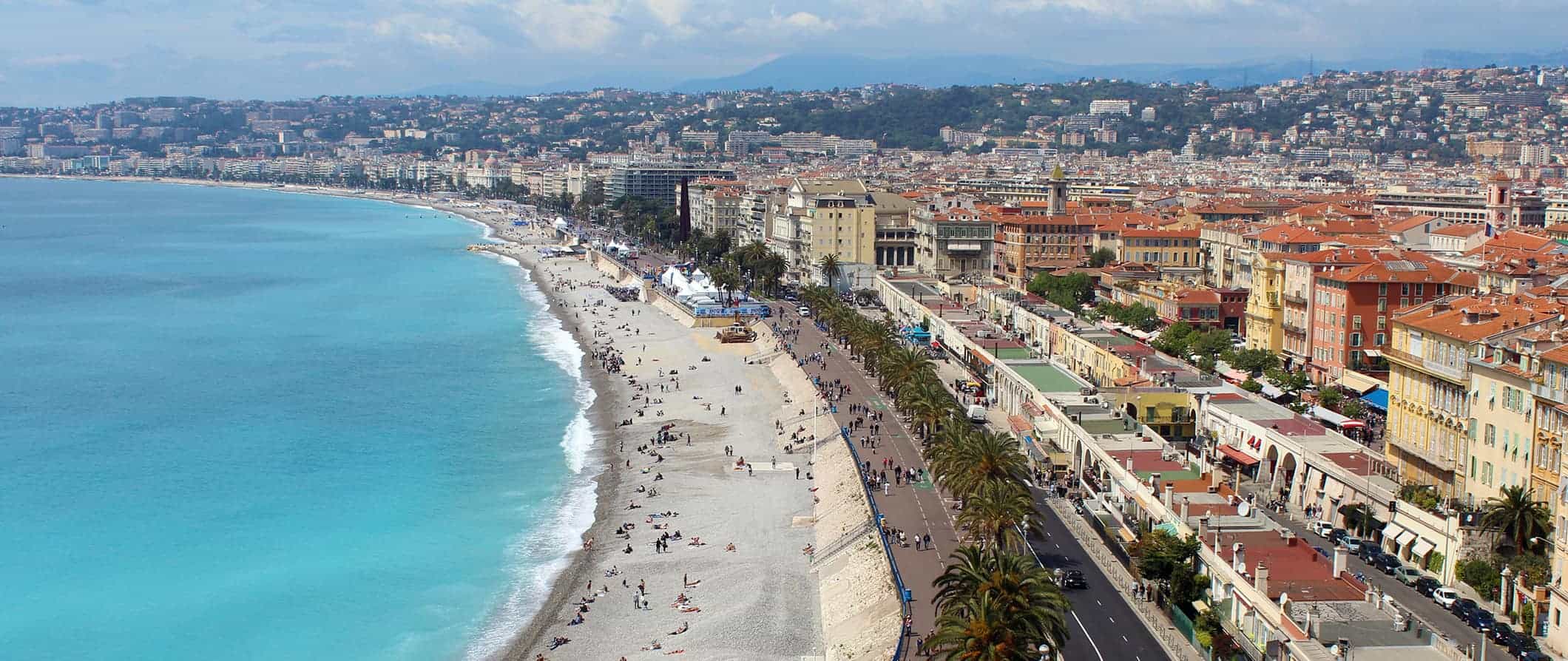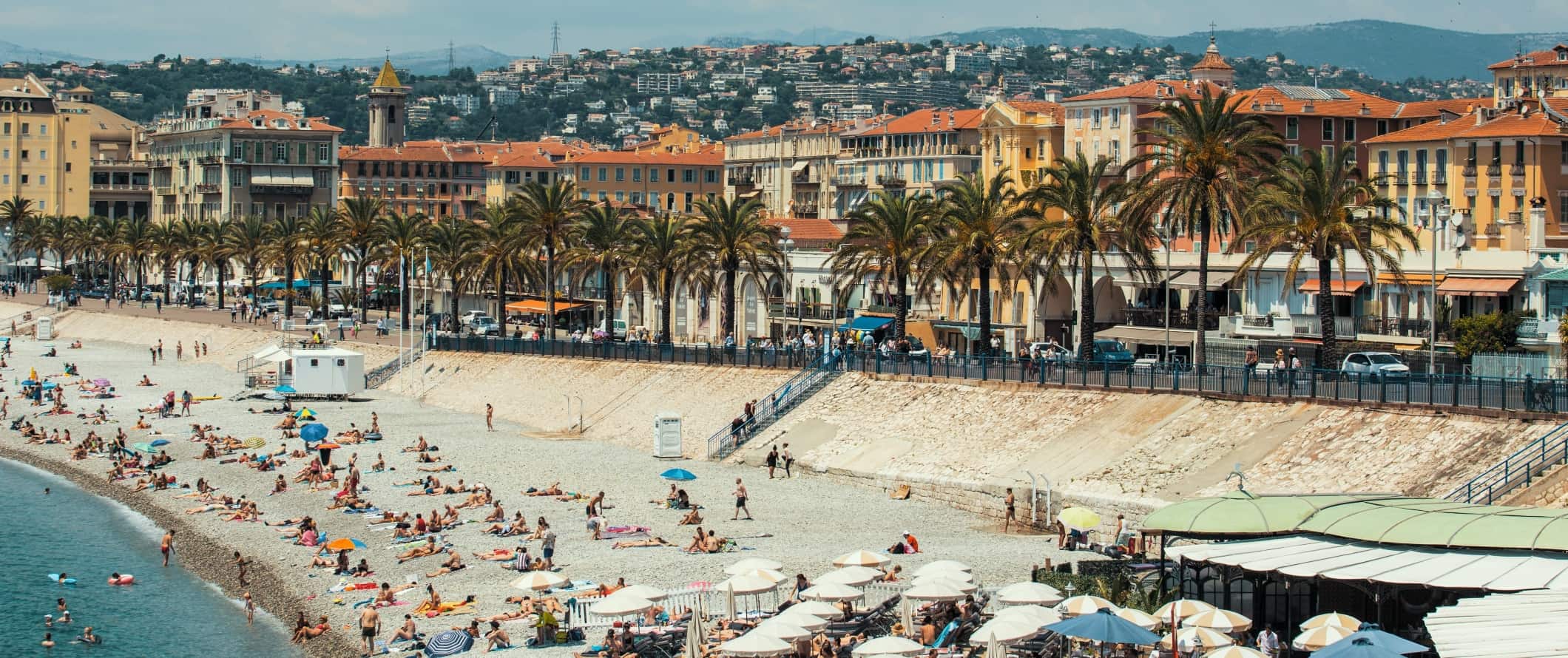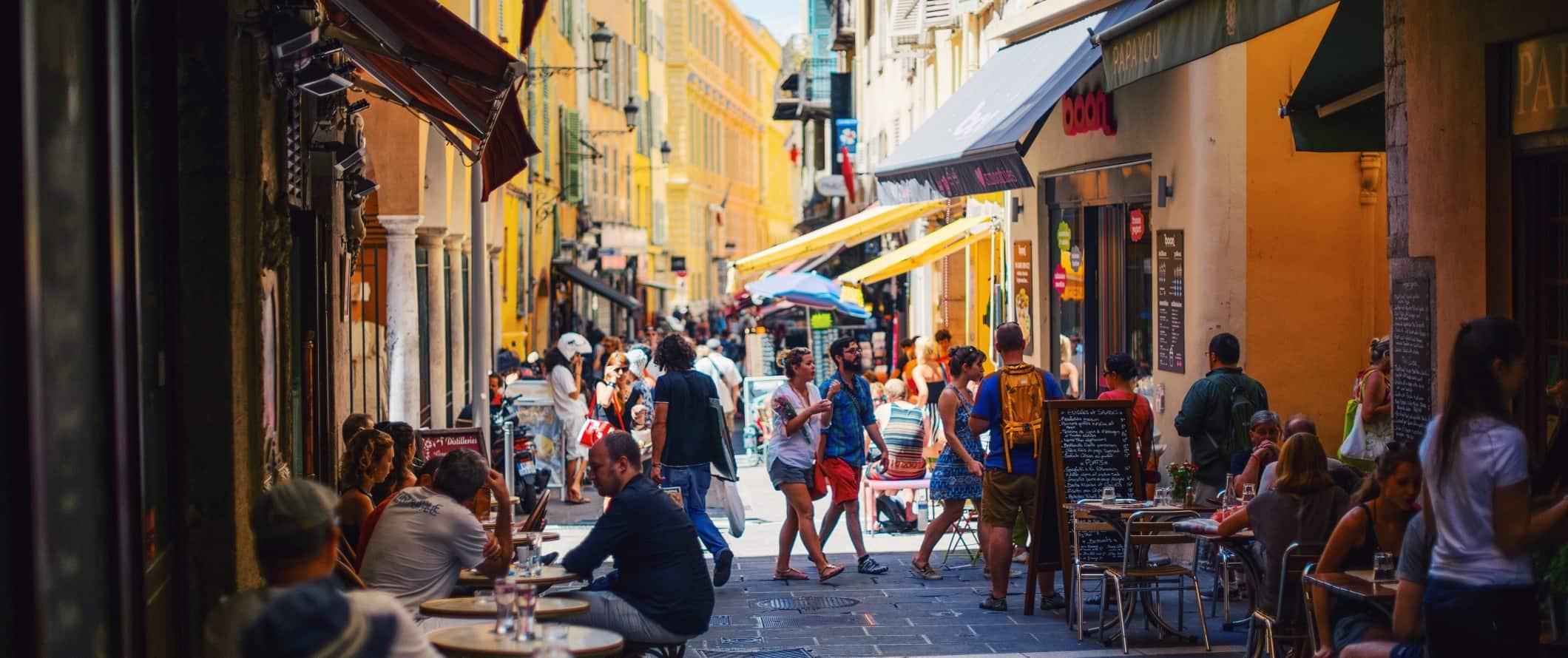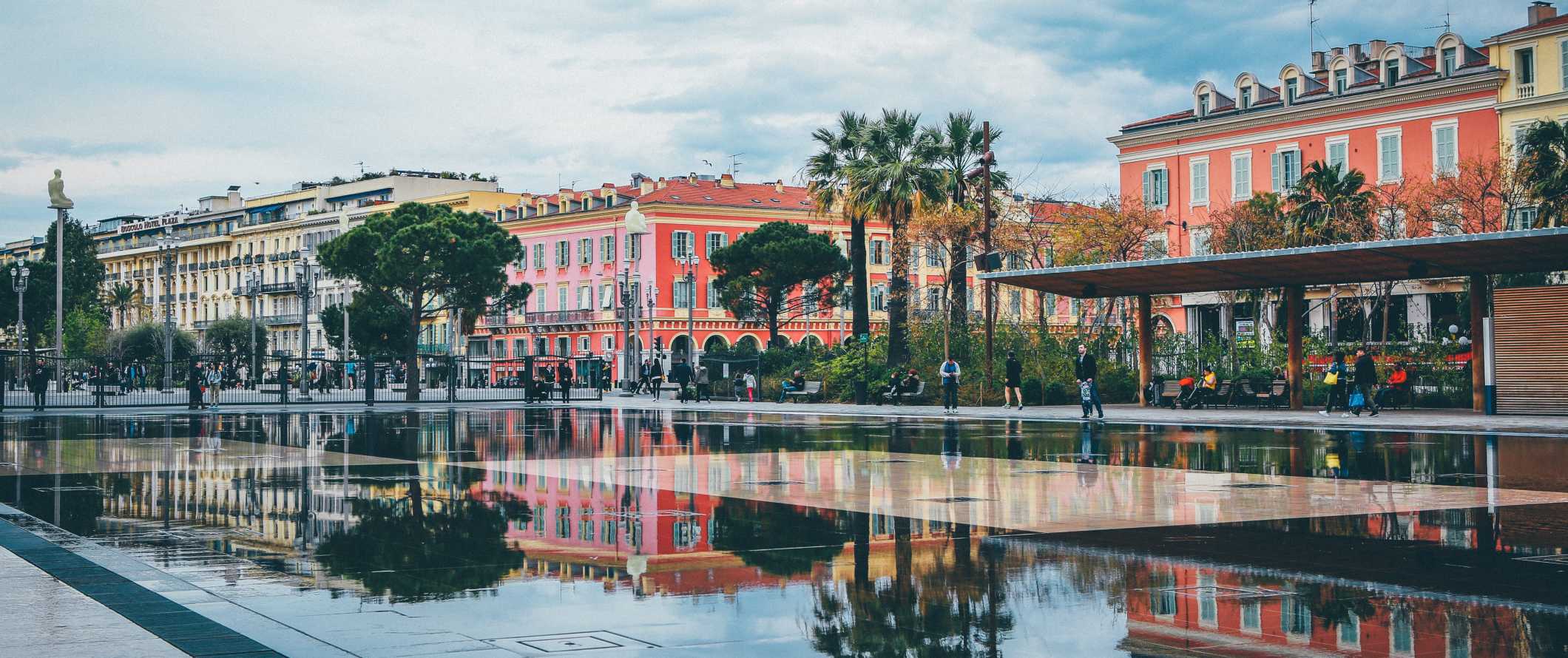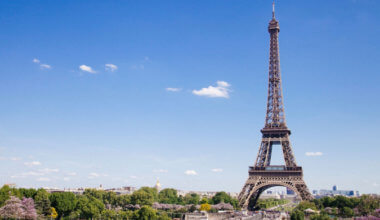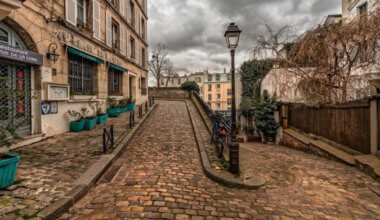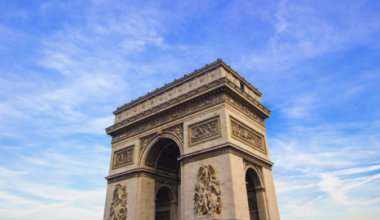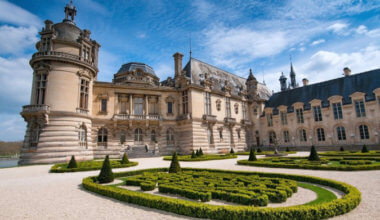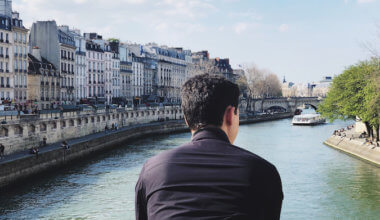Visiting Nice is, to use the old joke, nice. Located on the French Riviera, it’s the second-biggest tourist destination in the country. I’ve found the city a lovely place to stop on the way to smaller, even quainter Riviera towns. Nice has wonderful hilltop lookouts, restaurants, glamor, tons of scenery, and beautiful beaches.
While not known for its history, settlements here stretch back a whopping 400,000 years (Homo Erectus artifacts have been found here). The city as we know it today was likely established around 350 BCE by the Greeks. That settlement evolved into a large trading hub, which expanded through the Middle Ages into the city we know today.
These days, Nice is known for its upscale atmosphere. The city’s glitz means that there are very few budget options, but it’s worth a night or two to take in the sights and admire the fleet of yachts that usually dot the harbor. After a couple of days, head down to the nearby beach towns of the Cote d’Azur.
This travel guide to Nice can help you plan your trip, save money, and make the most of your time in this gorgeous city!
Table of Contents
Top 5 Things to See and Do in Nice
1. Walk the Promenade des Anglais
This seaside promenade is one of the main hubs of the city. Vendors sell fresh-made crepes and, best of all, there are nice (get it?) restaurants on the beach. Try Le Koudou for seafood or Les Jardins du Capitole for French classics like tartare.
2. Visit the Matisse Museum
Artist Henri Matisse moved to Nice at 48 and remained in the city until his death in 1954. It was during this time that Matisse painted some of his most famous works, including The Sheaf, Nu bleu, Sorrow of the King, and others. Admission is 10 EUR.
3. Relax at the beach
The beaches of Nice aren’t great when compared to the surrounding area but there are still some noteworthy ones to visit. La Réserve is known as one of the best beaches in Nice. Plage Beau Rivage and Coco Beach are both quite nice as well.
4. Wander Vieux Nice
Below the hill of the main city, the old town is a maze of streets and tight alleyways. There are numerous boutiques, markets, crêperies, and cafés. Nice was Italian until the signing of the Treaty of Turin in 1860, so Vieux Nice has a very Italian feel to it.
5. See the Nice Port
Port Lympia is a great spot to watch boats coming and going. In the summer, you can even take a free ferry, called Lou Passagin, across the harbor. Some of the hippest bars are located here as well. Boston Bar and Ma Nolan’s are both excellent choices.
Other Things to See and Do in Nice
1. Visit the Cours Saleya Flower Market
Nice is known for its flowers. In 1897, it was the first city in the world to open a wholesale cut flower market. This tradition runs strong to this day, and the market is lined with cafes, shops, and aisles upon aisles of fresh flowers. While the market is known for its flowers, there are also many local produce stands as well. It’s open six days a week from 6am-5:30pm except for Monday and Sunday afternoons when there’s a flea and antique market instead (also cool to visit). Mornings are the best time to visit as the flowers are the freshest and the crowds the smallest.
2. Head to La Colline du Château (Castle Hill)
The Castle of Nice (Château de Nice) was built in the 11th century, remaining an active citadel until the early 18th-century when King Louis XIV commanded that it be destroyed. Today, the area where the Chateau once stood is a popular green space and look-out, with one of the best panoramic views of Nice and the sea. You can take an elevator or hike up the stairs, but it’s a long, long walk. I usually take the elevator up and hike down. You can walk up from the promenade or via the town. (I prefer walking up via the old town as it’s more scenic.)
4. Tour the Museum of Asian Art
Located beside a man-made lake in Phoenix Park, Japanese architect Kenzo Tange designed the museum to be a meeting point between Asian and Western cultures. One of Nice’s newer museums, it opened its doors in 1998 and has a brilliant collection of Indian, Chinese, and Southeast Asian art. The India exhibit is exceptionally good. Entrance is free. There are also paid (10 EUR) weekend workshops on Asian art forms such as Japanese and Chinese calligraphy and origami. A traditional tea ceremony takes place every Sunday at 3pm (10 EUR).
5. Visit the Museum of Modern and Contemporary Art
Opening its doors in 1990, the MAMAC focuses on postwar pieces, with more than 1,300 works of art in its collection. The museum has four connected wings, each featuring modern and contemporary art. There is a great collection of sculptures, conceptual installations, and paintings, as well as temporary rotating exhibitions. Admission is 10 EUR.
6. Take a day trip to Monaco
Monaco is a small city-state known for its luxe atmosphere. Even if you can’t afford to stay in this luxurious city, you can still visit for the day. You can spend the day exploring the casinos, yachts, and chic restaurants lining the water. While you’re here, visit the Palace of Monaco, a castle built in 1191. As it’s the official residence of the Sovereign Prince of Monaco, tourists can only visit seasonally. You can visit the prince’s staterooms (8 EUR), see the royal collection of cars (8 EUR), or meander Monaco’s zoological gardens (6 EUR). The bus takes 45 minutes and costs 1.50 EUR. The train takes 20 minutes with tickets starting as low as 3.50 EUR. The Monaco F1 Grand Prix is held here annually in May or June, attracting thousands of visitors.
7. See St. Nicholas Russian Orthodox Cathedral
This cathedral is the largest Eastern Orthodox cathedral in Western Europe. When one of Tsar Aleksandr II’s sons died in Nice at the beginning of the 20th century after coming down with meningitis, this cathedral was later dedicated to him. Built in the Russian Revival style, the cathedral has teal and green-tiled domes topped with silver crosses. Inside there’s a golden altar and vibrantly painted walls. A dress code is strictly enforced so don’t wear shorts if you want to enter. Cameras are not allowed inside either.
8. Tour the Musée National Marc Chagall
A Russian-French artist of Belarusian Jewish descent, Chagall is known for his cubism and expressionism pieces. Located north of Vieux-Nice in the neighborhood of Cimiez, Musée National Marc Chagall features the artist’s religious works, particularly pieces depicting the resurrection, the sacrifice of Isaac, Adam, and Eve. The Fiddler and Bella with White Collar are among his more popular pieces. Built in 1973, Chagall was active in the museum up until his death in 1985. Admission is 8 EUR, with free admission on the first Sunday of the month.
9. Visit the Cimiez Hill district
If you visit the Matisse Museum, you’ll find yourself in Cimiez Hill district, located about 2 kilometers (1.2 miles) from Nice’s Old Town. But there’s even more to explore in this area, including the tranquil Cimiez Monastery Gardens, the Archaeological Museum (5 EUR), and the ruins of a Roman amphitheater.
10. Take the Wonder Train
The Train des Merveilles is a two-hour train journey from Nice to the picturesque mountain village of Tende. On this scenic ride, the train makes its way through the mountains, offering breathtaking views of gorges, valleys, and the sea. Take the 9:15am train so you can arrive by late morning, explore the town, have lunch, see the free museum, and then catch a train back to Nice in the evening. A round-trip ticket is 27 EUR, though there are often special discounted offers in the summer.
For more information on other cities in France, check out these guides:
Nice Travel Costs
Hostel prices – There are several hostels in Nice within walking distance to the beach, starting at 22-26 EUR for a 4-6-bed dorm. A bed in a dorm with 8-12 beds costs around 14-18 EUR per night. Private rooms start at 60 EUR per night. Expect standard amenities like free Wi-Fi and self-catering facilities.
Budget hotel prices – You can find budget hotels located in the city center with free Wi-Fi and air-conditioning starting at 50-65 EUR per night.
On Airbnb, you can find private rooms starting at 40 EUR per night and entire apartments starting at 65 EUR per night (though double or even triple that is more likely if you don’t book in advance).
Food – Food in France has a long history and is intricately intertwined with the culture. Fresh bread (especially baguettes), tasty local cheeses, and plentiful wine may be stereotypical staples of the cuisine, but they really are some of the must-eat foods in the country. Be sure to also try croque monsieur (a hot ham and cheese sandwich), pot-au-feu (beef stew), steak frites (steak and fries), and if you’re really adventurous you can sample traditional delicacies like frog legs, escargot (snails), or foie gras (a fattened duck or goose liver).
If you go out to eat, expect to spend 9-13 EUR for starters, 15-30 EUR for a main dish, 5-10 EUR for desserts, and 4-9 EUR for wine.
To save money eating out, try doing a prix-fixe meal. It’s a set menu that offers you a deal on a 2-3 course meal. It’s the cheapest at lunch at about 15 EUR.
La Rossettisserie in Vieux-Nice is a carnivore’s dream with a menu filled with red meat and poultry dishes, for around 17 EUR. Illia Pasta on rue Droite in Old Nice is also a delicious choice, with dishes under 15 EUR. In the neighborhood of Jean-Médecin, Le Vingt4 is a vibrant Mediterranean and French restaurant with tapas for 9-16 EUR.
Fast food or ready-made sandwiches cost about 6 EUR. A combo meal at McDonald’s costs around 9 EUR.
Beer costs 6-7 EUR while a cappuccino/latte is around 3 EUR. Bottled water is 1 EUR.
If you plan on cooking your own food you can buy a week’s worth of groceries for 50 EUR. This gets you basic staples like pasta, bread, seasonal produce, and some meat or seafood.
Backpacking Nice Suggested Budgets
If you’re backpacking Nice, my suggested budget is 70 EUR per day. This budget covers staying in a hostel dorm, cooking all of your meals, limiting your drinking, taking public transit and walking to get around, and doing most free or cheap activities like enjoying the beach and wandering Vieux Nice.
A mid-range budget of about 140 EUR per day covers staying in a private Airbnb, eating out for a few meals, enjoying a few drinks, taking the occasional taxi to get around, and doing more paid activities like visiting museums and day-tripping outside the city.
For a “luxury” budget of 285 EUR per day or more, you can stay in a hotel, eat out for all your meals, drink as much as you want, take more taxis or rent a car, and do whatever tours and activities you want. This is just the ground floor for luxury though. The sky is the limit!
Nice Travel Guide: Money-Saving Tips
Nice is built for the luxury traveler. Being on the French Riviera and so close to many expensive destinations, it’s a city people visit to spend money. But if you want to lower your costs, here are some ways to save money in Nice:
- Do free stuff – Take advantage of all of the free sights including the beach, Vieux Nice, Jardin Albert I (the city’s central park), and the Promenade des Anglais, which fills up at night with music and street performers. You can see a lot here without spending a cent!
- Get a French Riviera Pass – Available at the Nice Tourism offices, the Congress Centre, and various hotels around the city, the French Riviera Pass gives you free access to many of the main museums in Nice and the Côte d’Azur, as well as unlimited travel (including to the airport) during your chosen time frame. Passes are 26-56 EUR for 24, 48, or 72-hour periods. The pass also includes an Old Nice guided tour and Lascaris Palace.
- Use the Nice Museum Pass – This pass gives you unlimited access to all of Nice’s museums for 72 hours. At 15 EUR, it’s a great deal if you love museums.
- Get the set lunch menu – If you eat out, do so at lunch and get the prix-fixe menu. Restaurants throughout town offer this set menu during lunch, and with prices between 10-20 EUR, it’s a way better deal than the regular dinner menu!
- Take the free walking tours – Free Walking Tour Nice has a free walking that’s a great introduction to the city. Just be sure to tip your guide at the end!
- Stay with a local – If you want to save money and get some local insight into the city, use Couchsurfing. Staying with a local is the best way to get a feel for the city and learn some insider tips.
- Bring a water bottle – Since the tap water here is safe to drink you should bring a reusable water bottle to save money and reduce your plastic use. LifeStraw is my go-to brand as their bottles have built-in filters to ensure your water is always clean and safe.
Where to Stay in Nice
There is a handful of hostels in Nice to choose from, most of which are quite close to the city center. Here are my recommended places to stay in Nice:
How to Get Around Nice
Public transportation – A single-fare ticket costs 1.50 EUR and allows for unlimited travel on both bus and travel for 74 minutes. You can also purchase a 10-trip pass for 10 EUR, a day pass for 5 EUR, and 7-day pass for 15 EUR.
There is also a free shuttle bus that goes down Victor Hugo Boulevard and loops around to the promenade and Old Town, before returning to the start. It’s a red electric bus that you just hop on and off.
Nice has several night-time bus routes which run from 9:10 pm to 10:10 am each day, making it easier to get around if you’re out late at night.
Bicycle – Vélobleu is a public bike-sharing system that lets you use bicycles around the city. There are 175 stations in the region and over 1,700 bikes. It is 1.50 EUR for a day pass (3 EUR for an e-bike), with the first 30 minutes free. If you have a bike out for more than 30 minutes, it’s 1 EUR for the second half-hour and 2 EUR for each additional hour.
You can also rent bikes for the entire day from local bike shops, such as Bike Trip or Booking Bikes. Day rentals are 10-20 EUR.
Taxi – Taxis are expensive in Nice, with a base rate of 3.50 EUR plus another 2.08 EUR per kilometer. This rate may increase in the evenings so skip the taxis if you can — they add up fast!
Ridesharing – Uber is available in Nice and is generally cheaper than taxis. For getting around the area (and the country) you can also use the ride-sharing app BlaBlaCar. It is a great way to travel around Europe on a budget.
Car Rental Car rentals can be found for as little as 27 EUR per day for a multi-day rental. Unless you’re planning to head out of the city, I would skip the car rental. Parking is expensive and you don’t need a car to get around the city.
When to Go to Nice
June-August are the hottest and most popular months to visit Nice. Temperatures average 30°C (86°F) and this is when the south of France is packed with locals and tourists who want to soak up the sun. Prices are also the highest and you’ll need to book well in advance.
The crowds in summer can be quite large at times, especially close to the beaches and in Old Nice. Prices in restaurants and hotels increase as well. To avoid crowds, venture into some of the local neighborhoods, such as Jean-Médecin or Carabacel.
In September and October, the average high temperature is 24°C (75°F). This is an ideal time to visit Nice. The crowds are considerably smaller, making it an ideal time to relax on the beach and wander through the streets of Old Nice and other popular areas.
December to April is considered the winter season and temperatures average around 12°C (55°F). Prices during this time are lower, and the streets are quieter. The exception to lower prices is during the Nice Carnival, which takes place for 14 days each February/March. A tradition since 1873, this is one of the best carnivals in Europe, known for its over-the-top colorful float parades during the day, a parade of lights at night, and beautiful flower parade.
The Nice International Film Festival occurs every May when the city is flooded with celebrities and more glitz and glamor than one can handle. Book in advance if you’re visiting during this time.
How to Stay Safe in Nice
Nice is very safe — even if you’re traveling solo and even as a solo female traveler. The risk of violent crime here is very low.
As in any destination, the standard precautions apply (never leave your drink unattended at the bar, never walk home alone intoxicated, etc.). Avoid walking through unfamiliar areas alone at night and beware of pick-pocketing and petty theft. Pickpocketing is common in markets, on buses and trains, and other crowded areas. Always keep your valuables secure and out of reach just to be safe.
Avoid bringing valuables to the beach, as theft while you’re in the water can occur. Keep your valuables secure when eating out as bag snatching can occur.
The petition scam is quite popular, where someone asks you to sign a paper and while you’re distracted with the clipboard, they’ll pick your pockets or demand a “donation.” Politely decline anyone approaching with a clipboard or papers.
If you’re worried about getting ripped off you can read about common travel scams to avoid here.
If you do experience an emergency, dial 112 for assistance.
Always trust your gut instinct. Avoid isolated areas at night and be aware of your surroundings at all times. Make copies of your personal documents, including your passport and ID. Forward your itinerary along to loved ones so they’ll know where you are.
The most important piece of advice I can offer is to purchase good travel insurance. Travel insurance will protect you against illness, injury, theft, and cancellations. It’s comprehensive protection in case anything goes wrong. I never go on a trip without it as I’ve had to use it many times in the past.
Nice Travel Guide: The Best Booking Resources
These are my favorite companies to use when I travel. They consistently have the best deals, offer world-class customer service and great value, and overall, are better than their competitors. They are the companies I use the most and are always the starting point in my search for travel deals.
- Skyscanner – Skyscanner is my favorite flight search engine. They search small websites and budget airlines that larger search sites tend to miss. They are hands down the number one place to start.
- Hostelworld – This is the best hostel accommodation site out there with the largest inventory, best search interface, and widest availability.
- Booking.com – The best all around booking site that constantly provides the cheapest and lowest rates. They have the widest selection of budget accommodation. In all my tests, they’ve always had the cheapest rates out of all the booking websites.
- HostelPass – This new card gives you up to 20% off hostels throughout Europe. It’s a great way to save money. They’re constantly adding new hostels too. I’ve always wanted something like this and glad it finallt exists.
- Get Your Guide – Get Your Guide is a huge online marketplace for tours and excursions. They have tons of tour options available in cities all around the world, including everything from cooking classes, walking tours, street art lessons, and more!
- The Man in Seat 61 – This website is the ultimate guide to train travel anywhere in the world. They have the most comprehensive information on routes, times, prices, and train conditions. If you are planning a long train journey or some epic train trip, consult this site.
- Rome2Rio – This website allows you to see how to get from point A to point B the best and cheapest way possible. It will give you all the bus, train, plane, or boat routes that can get you there as well as how much they cost.
- FlixBus – Flixbus has routes between 20 European countries with prices starting as low 5 EUR! Their buses include WiFi, electrical outlets, a free checked bag.
- SafetyWing – Safety Wing offers convenient and affordable plans tailored to digital nomads and long-term travelers. They have cheap monthly plans, great customer service, and an easy-to-use claims process that makes it perfect for those on the road.
- LifeStraw – My go-to company for reusable water bottles with built-in filters so you can ensure your drinking water is always clean and safe.
- Unbound Merino – They make lightweight, durable, easy-to-clean travel clothing.
- Top Travel Credit Cards – Points are the best way to cut down travel expenses. Here’s my favorite point earning credit cards so you can get free travel!
- BlaBlaCar – BlaBlaCar is a ridesharing website that lets you share rides with vetted local drivers by pitching in for gas. You simply request a seat, they approve, and off you go! It’s a cheaper and more interesting way to travel than by bus or train!
Nice Travel Guide: Related Articles
Want more info? Check out all the articles I’ve written on backpacking/traveling France and continue planning your trip:
